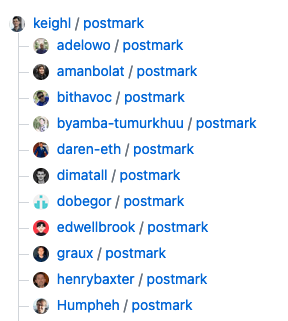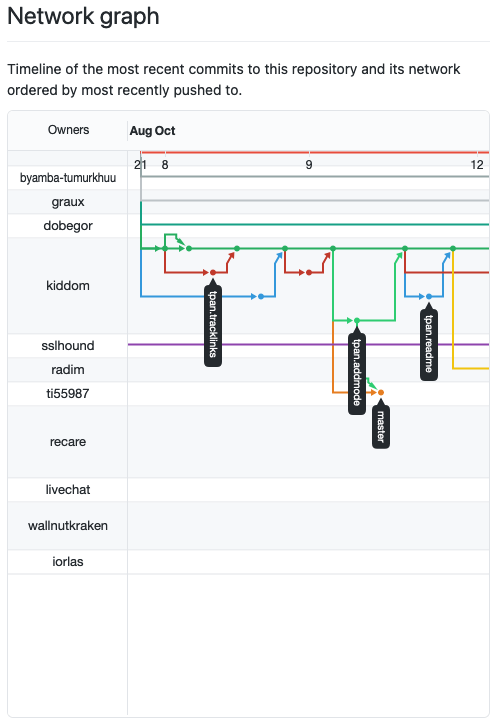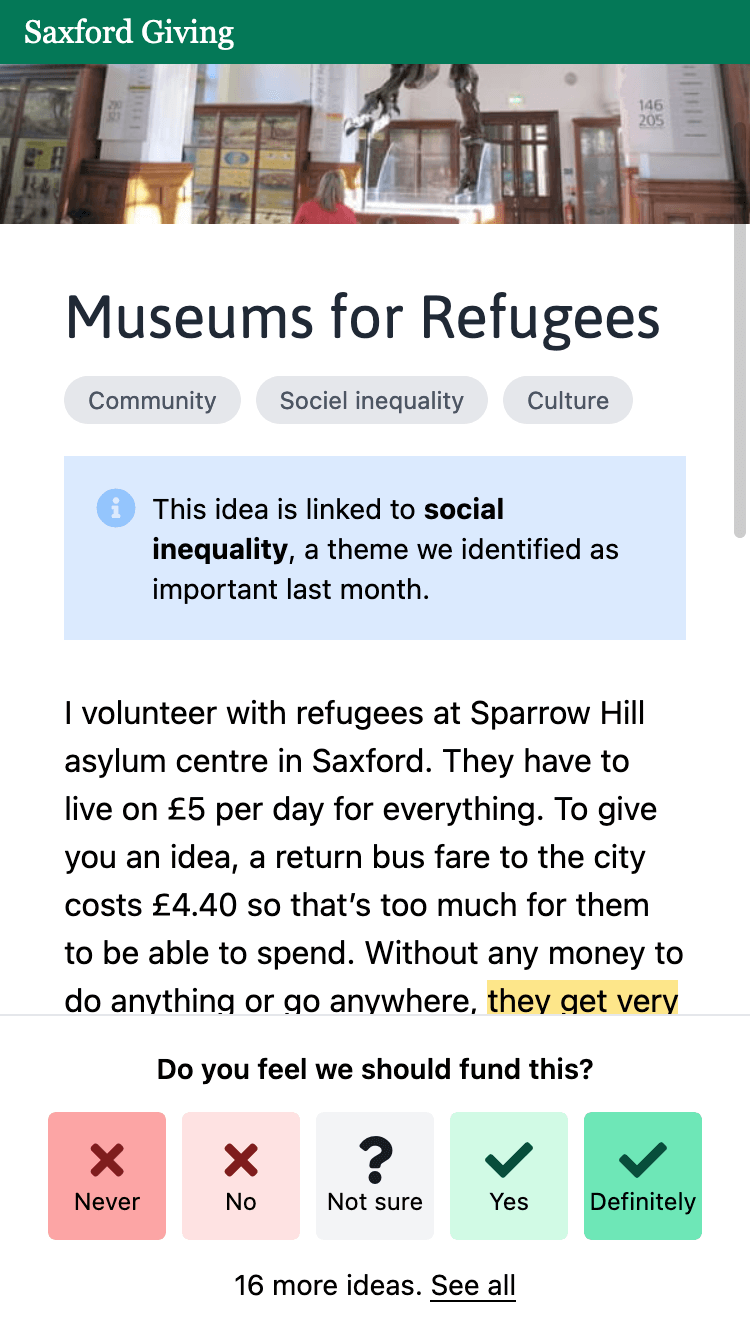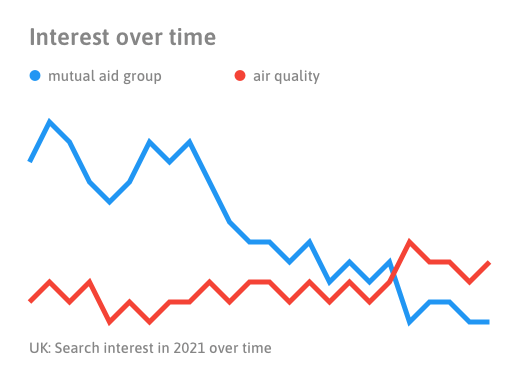Opportunities for data
A software-powered organisation like Saxford Giving could generate a lot of insightful data.
Scaling up to thousands of similar organisations could provide a network effect with even more benefits.
In order to realise the benefits, the software would have to expose structured data. That means websites that are built to be read by humans as well as machines. This could create a federation of connected organisations (and avoid creating a bunch of silos).
Here we discuss four opportunities areas that didn’t make it into the prototype but are important to consider.
Network of ideas
We’re conscious that we started the prototype at the point of applying for funding. That assumes that good ideas are already out there, waiting to be funded.
That assumption may not be true so we wanted to think more about upstream of applying. Are there opportunities to help with idea generation and stretching ideas?
One area that the fictional Saxford Giving story could help is idea sharing.
Let’s stop thinking about ideas as belonging to a particular place. To borrow a word from programming, what if ideas could be “forked” (copied and adapted) from one place to another?

Screenshot of forks of a Github project showing a number of users who have each ‘forked’ (copied and adapted) the ‘postmark’ project
Of course, many ideas in one place aren’t applicable outside that place.
But some ideas do have more broad applicability. For example, Participatory City have identified certain projects that are good at building social cohesion and could be applied in many different places. They just need a “host” in a place to pick them up.
The software behind Saxford Giving should understand the concept of “forks” - when one project is derived from another - to enable a sort of network of ideas.
This would allow a couple of things.
It would make it possible to spot certain ideas that seem to get forked often. Perhaps these could be amplified? Other giving organisations could see these ideas and put out calls for someone to take on the idea, ready made and ready to go.
It could help build cross-region networks of people working on similar ideas. Someone who wants to start a new community food hall could see a network graph for that idea, allowing them to contact everyone running the project in different places.

Github network graph showing how different users' adaptation of the project relate to one another.
Thanks to Louis from Foodhall for inspiration in this section.
Search
Discrete labels are reductive
Funders like to categorise or label projects. They try to fit them into neat boxes. This helps them balance their funding - ensuring they fund a mix of projects. It helps them with reporting - showing what issues their fund has tackled.
We don’t believe people actually running projects think of their idea as a “loneliness project”. Rather, they think of all of the benefits, not necessarily fitting into neat categories.
While designing the prototype, we got drawn into this too. It was tempting to show labels on projects, for example “social inclusion”, “food waste” and so on.

But adding the label’s ‘community’ ‘social inequality’ and ‘culture’ broke the fiction. In the world we imagined with Saxford Giving, there is no central authority to assign categories. There’s no funder with staff to do this, only members.
Perhaps members could propose labels individually. When several members proposed the same label, FacilitatorBot could see that and assign that label to the idea. That’s a bit like the “popular highlights” pattern you see on Kindle and Medium, where sections of text that are highlighted by many users end up highlighted for everyone.
But what purpose do labels actually serve? Who are they for?
Perhaps labels are valuable so that members of Saxford Giving can look back at funding decisions by label. They could see that over the last few years they’ve funded “food waste” and not much “social inclusion”. Is that useful?
Perhaps labels help with the “network of ideas”. Someone in Stoop Heath is concerned about food waste and is able to look at projects from other places related to that label?
Search as a way to discover projects
We think a better approach is to enable search across the text of all ideas, questions and comments. This should work across all places: Saxford Giving, Stoop Heath Community Fund, and so on.
There’s a good reason Google won over the directories, where websites were added and manually labelled with relevant keywords. Google’s approach was to index the text from every website and rank them cleverly to show the most relevant at the top of the results.
Being able to search for project ideas is more powerful than browsing by label. Labelling is a form of gatekeeping and it’s a task that can be easily forgotten, neglected, or done inconsistently.

Free text search gives the power back to the individual to interrogate the data in the way they want. If someone wants to look for ideas related to air quality, they can search for “air quality”, “pollution”, “traffic” and so on. They’ll see projects for those words, rather than being limited to someone else’s label.
Ranking is an exciting challenge! How to show search results with the most relevant first?
Without a central authority in the middle with their own bias you have to rely on other signals. Ranking signals might include the number of times an idea’s web page was mentioned on social, how many times it’s been “forked”, how many page views it has. Like Google, responding to user behaviour (most people click the 3rd link: that should probably be at the top).
This data could be exposed by the software underlying Saxford Giving, making it easy for a search tool to ingest all ideas from all places and interpret them for ranking.
In summary, it should be possible to search for ideas from all places. We think that’s more important than labels.
Meetups
The prototype as it stands conveys a very online version of Saxford Giving.
We heard about the importance of face to face contact in the participatory grant-making community. Even FundAction, whose proposals and voting are done online, hold an annual congress where they come together to meet in person.
In-person meetups are important for building trust and solidarity and for chance encounters, among other things. We think it’s important that the members of Saxford Giving meet up in real life to build connections that are difficult to build online.
It may also be an opportunity for members to meet applicants or people who might want to become applicants. It could be an opportunity to demystify the organisation and show that it’s just regular people.
We think FacilitatorBot is in a good position to help organise physical meetups between members. There’s a lot it could help with: send Doodle polls to find dates, ask who’d like to host and select someone, send calendar reminders, and so on. Much of the work of organising a meetup could be automated, ensuring it always happens.
That’s similar to Meetup.com, where the platform prompts group owners to arrange a meetup, tells members about the new event, collect RSVPs, sends follow-ups afterwards and so on.
Diversity
Everyone we spoke to told us the importance of diversity of members. Diversity is essential for reflecting the true views of a community and it’s essential that traditionally under-represented groups or groups that experience stigma because they operate outside of the status quo are meaningfully included.
If you start with a diverse membership, more diverse projects will follow.
In the prototype, Saxford Giving is presented as a membership that already exists: we didn’t address how members were recruited.
If Saxford Giving were to exist for real, it would need careful thought about how to recruit a diverse membership. Otherwise it could easily recreate some of the historical criticisms of funders:
- not representative of the communities they serve
- detached from the lived experience that is needed to make relevant decisions
- in positions of comfort and thereby not willing to take risks on ‘edgy’ ideas - or having a skewed perception of risk
That starts with the team: we’re two white guys running this project and we recognise the bias that gives to the project. The project ideas we selected, the words we used and the design decisions we made. Any product contains the bias of its designers. If this were to be built for real, it should have a diverse team.
Revealing diversity within the membership
We had some ideas about how a community like Saxford Giving might try to understand, improve and maintain its own diversity.
What if members provided a little demographic information about themselves, and that were shown against census data for Saxford?
| Saxford | Members | ||
| Asian | 7.5 % | 7.5 % | |
| Black | 3.3 % | 0.2 % | under represented |
| Black African | 1.8 % | 0.2 % | |
| Black Caribbean | 1.1 % | 0.0 % | |
| Black other | 0.5 % | 0.0 % | |
| Mixed | 2.2 % | 2.2 % | |
| Mixed White/Asian | 0.6 % | 0.6 % | |
| Mixed White/Black African | 0.3 % | 0.3 % | |
| Mixed White/Black Caribbean | 0.8 % | 0.8 % | |
| Mixed other | 0.5 % | 0.5 % | |
| White | 86.0 % | 89.1 % | over represented |
| White British | 80.5 % | 83.6 % | |
| White Irish | 0.9 % | 0.9 % | |
| White Gypsy/Traveller | 0.1 % | 0.1 % | |
| White other | 4.4 % | 4.4 % | |
| Other | 1.0 % | 1.0 % | |
| Arab | 0.4 % | 0.4 % | |
| Any other | 0.6 % | 0.6 % |
Illustrative figures: “Saxford” ethnicity is taken from the 2011 census, population of England and Wales.
Being transparent about the diversity of the membership is the first step to addressing it.
Revealing this data makes it easy to spot areas where the membership is not representative of Saxford
To illustrate the point we’ve used ethnicity because there’s census data available. But diversity is not just about age, ethnicity, race, gender etc. It’s also important to consider diversity between lived, learned and practice experience, between disciplines, between ‘sectors’ and so on.
We showed how FacilitatorBot could invite new people to become members. Perhaps it could automatically weight those invitations based on gaps in diversity - e.g. only invite women for a while if there’s a gender imbalance. Even with this idea we need to proceed with caution, perhaps that’s too much responsibility for a bot, even if the intention is good!
